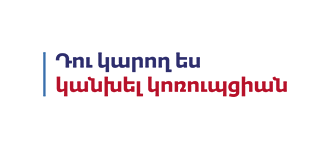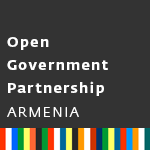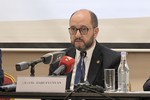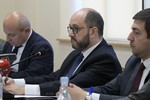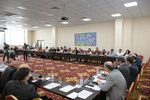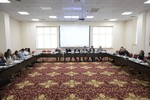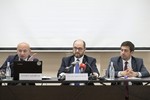Tuesday, 16 April 2024
Arayik Harutyunyan presents the priorities at the base of the new communication architecture and the planned programs in the field
Chief of Staff of the Prime Minister Arayik Harutyunyan participated in the XIII security forum of the Armenian Institute of International and Security Affairs (AIISA) on the topic "Challenges for Strategic Communication and Reforms in Armenia".
Specialists of the field, representatives of the diplomatic corps and international structures, civil society participated in the event.
In his speech, Arayik Harutyunyan welcomed the participants of the event and presented the steps taken by the Armenian government in the direction of forming a new architecture of strategic communication.
The Chief of Staff of the Prime Minister first noted that a series of reforms has been launched in this area, which is desirable for being more inclusive and ensuring more inclusion. Arayik Harutyunyan noted that quite a lot of work has been done in the direction of forming a new architecture of strategic communication and emphasized. “First, what is communication? It is a tool by which the best intentions can be brought to life, and those same best intentions can be neutralized, if they work incorrectly, presented in a negative light. And to carry out that process, there must be many tools on the table that will allow it to be done effectively. Providing clear, complete, accurate and timely information to citizens is one of the most important tasks of the government. And that is why we have embarked on this reform. At the same time, proper communication reduces misinformation, this is a fact, and increases and strengthens public trust in government."
Arayik Harutyunyan, referring to the issue whether the government is satisfied with the tools that exist and whether strategic communication is properly implemented, answered: "Let me say no, because if we were satisfied, we would not be aiming for these reforms. In recent years, Armenia has faced three major crises: pandemic, war and unstable post-war situation. And during this period, we have witnessed in its entirety all the gaps in strategic communication, but also the advantages that we have had so far."
Next, the Chief of the Prime Minister’s Staff identified the main problems that exist in the state system in the field of strategic communication. "I would like to say that they are, in particular, the structure of the departments responsible for the communication of the state departments of Armenia and the variety and difference of the functions of the communication teams," said Arayik Harutyunyan and added that an attempt was made to implement a number of changes here, but they were not crowned with real success.
"The Armenian state departments do not have approved communication programs, regulations and guidelines. This is also one of the biggest problems because the lack of these communication programs forces the systems to be mostly person-centered and decisions are made according to situations," said Arayik Harutyunyan, continuing to list the problems in the field of communication. "Institutional problems in the field of communication also arise due to weak information coordination between different bodies, lack of clarity of powers and functions, in some cases duplication of duties and functions, and lack of optimal task division. While analyzing the problems here, we also looked at what institutional bodies deal with all this, where we have dublications, and we tried to highlight these problems as well. Strategic communication planning is also an issue. Strategic communication or at least long-term action planning is not carried out or is poorly carried out by the departments. The new body, which I will talk about soon, will also have the task of developing a communication strategy together with the departments, so that starting from the embryonic stage of the reforms, we can present the problems on time, ensure inclusion, so that in the future there will be less resistance. There is also a lack of human and technical resources and inefficient distribution in the field of communication, which I spoke about in part."
The Chief of Staff of the Prime Minister emphasized that the international experience was studied for forming the communication strategy architecture. "During this time, we also referred to the international experience, we conducted a study of international experience, in particular, we looked at the experience of Lithuania, Estonia, Finland, the United Kingdom and Sweden. In all the studied countries, there is a centralization of the communication system or a tendency to centralization, which is due to a number of issues, in particular, the highly diversified media field and challenges related to the development of social media, the presence of multi-party systems, which can lead, for example, to the formation of coalition governments with the personal agendas of separate political figures, which can hinder the unified communication policy of the government, by framing the issue of communication as a matter of national security.
Now, what principles have we put at the base of the new communication architecture and what priorities have we chosen? These are good governance, transparency and accountability, participation, and innovation. Among the principles, we have also highlighted the implementation of data-based policies. What new architecture are we offering? A hybrid model of communication architecture is proposed, which involves the centralization of one group of functions and the delegation and networking of that to one group. In the process of developing this model, a comprehensive analysis of the Armenian government's public communication system, the main principles and priorities of the sector's policy were taken into account. According to this model, it is proposed to create a public communication office within the structure of the Prime Minister's Office, the purpose of which is to support and serve the government and state departments in the implementation of the coordinated communication function. The function of the office is to implement the public communication system at the strategic level, while the day-to-day work at the tactical level will continue to be carried out by the relevant divisions of the state departments.
Summarizing, Arayik Harutyunyan noted that work is being done in this direction with the wide involvement of donor organizations. "They help us both in concept development, new architecture, institution formation, development of procedures and communication programs. We will divide the programs into several groups, some of which I already mentioned, there will be programs of standard situations, there will be programs of emergency situations and there will be external programs," said the Chief of Staff of the Prime Minister.
Next, the topic of creating a new strategic communication architecture was discussed in a question-and-answer format.
Arayik Harutyunyan thanked for the productive discussion and noted that the observations made will serve as a basis for making the development of the strategic communication architecture more effective.

